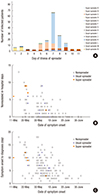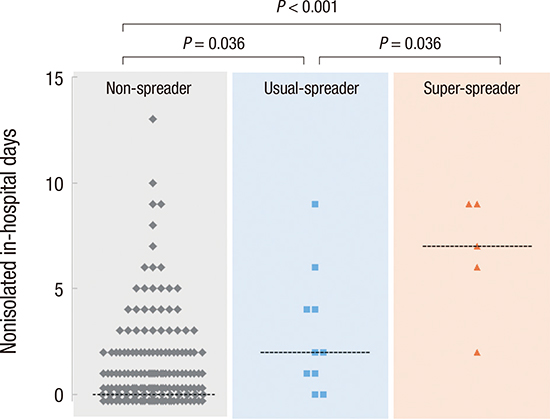INTRODUCTION
MATERIALS AND METHODS
Patients and data collection
Definitions and subgroup analyses
Statistical analysis
RESULTS
Baseline characteristics
Table 1
Comparison of patient demographics and clinical parameters between non-spreaders and spreaders, or usual-spreaders and super-spreaders during the 2015 Korean outbreak of MERS-CoV

Clinical characteristics
Epidemiologic characteristics
Table 2
Comparison of epidemiologic characteristics between non-spreaders and spreaders, or usual-spreaders and super-spreaders during the 2015 Korean outbreak of MERS-CoV

 | Fig. 1Epidemiologic characteristics of 2015 Korean MERS-CoV outbreak. (A) Cumulative number of infected patients according to day of illness of each spreader. When infected patients were exposed to a spreader for more than one day, the number of infected patients was equally divided by the duration (day) of exposure. Different colors denote infections transmitted by different spreaders. Note that the 5 super-spreaders transmitted the virus to 92% (161/175) of all cases. (B) Nonisolated in-hospital days according to the date of symptom onset of each patient. Two spreaders transmitted MERS-CoV to healthcare workers despite the fact that they had been isolated before their symptom onset. (C) Days from symptom onset to diagnosis according to the date of symptom onset of each patient.
MERS-CoV = Middle East Respiratory Syndrome Coronavirus.
|
 | Fig. 2Contribution of nonisolated in-hospital days to spreading events. (A) Nonisolated in-hospital days in non-spreader, usual-spreader, and super-spreader groups. Dashed lines denote median values at each group. Data points at 0 are shown at different level for clarity. (B) Number of spreaders (S) and infected patients (I), and I/S ratio according to nonisolated in-hospital days of spreaders. There were positive correlation between nonisolated in-hospital days of spreaders and I (red broken line) or I/S ratio (green broken line). |
Risk factors for transmission
Table 3
Forward stepwise multivariate analysis for risk factors for transmission of MERS-CoV





 PDF
PDF ePub
ePub Citation
Citation Print
Print




 XML Download
XML Download